AVADirect Clevo P170EM: Has AMD’s HD 7970M Got Game?
by Jarred Walton on October 2, 2012 1:35 PM ESTBattery Life and Power Draw
If we discount the overall design and build quality, so far we’ve seen very good performance from the P170EM with some nice LCD options as well. As noted earlier, however, battery life is not one of the strong points of Clevo in general, and the P170EM falls far short of the competition. We’re dealing with an Enduro equipped notebook, so when the dGPU isn’t being used it’s totally powered off—and the same goes for the Optimus version. If we take the Samsung Series 7 and Alienware M17x R4 as our baselines for what to expect from a 17.3” notebook and factor in battery capacities, the P170EM and its 77Wh battery ought to be able to deliver somewhere between 293 to 439 minutes of idle battery life. The Alienware M17x actually isn’t all that optimized for power use, while the Samsung Series 7 is clearly tuned for power savings when set to the “Power Saver” profile. We set the P170EM for ~100nits (28% brightness in this case, which actually results in around 130nits—the next step down at 14% brightness gives 70nits, so we opted for a slightly brighter display) and ran our standard battery life tests…

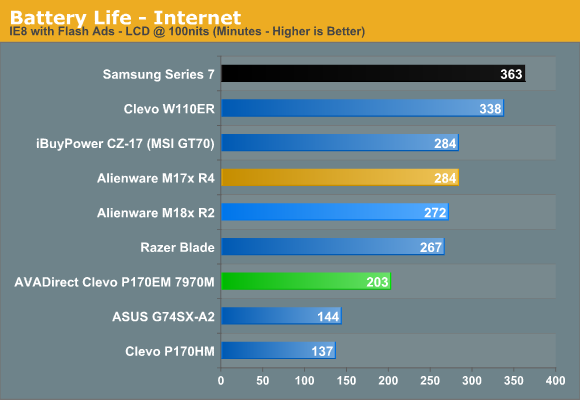

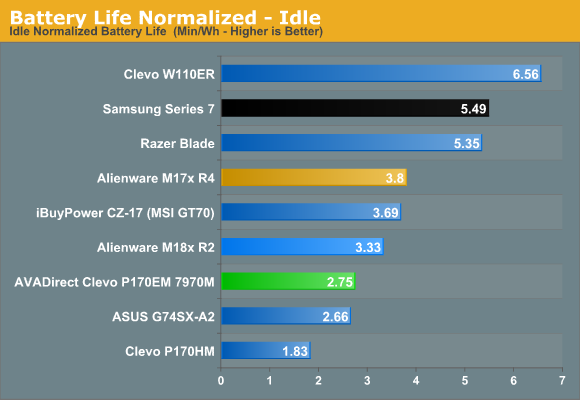
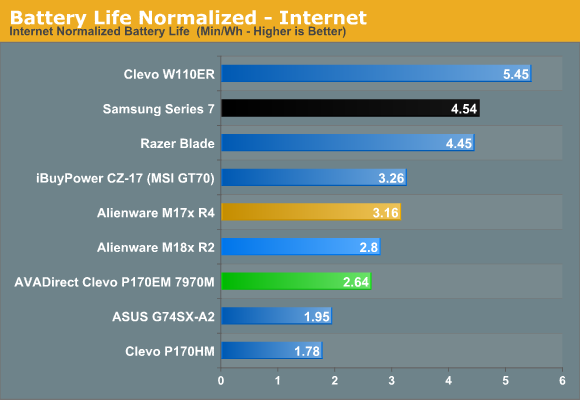
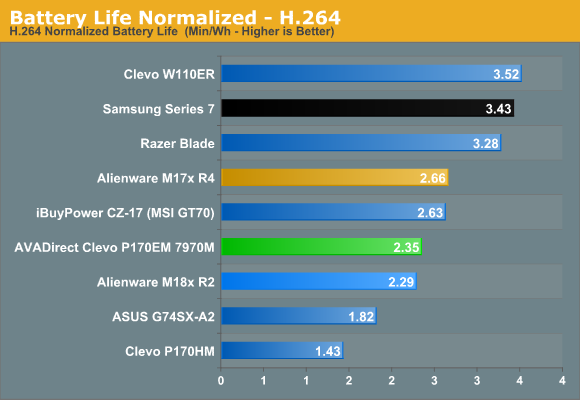
…And that’s what you get when a company doesn’t pay much attention to tuning a design for lower power use. What’s shocking is that the difference between our best-case Idle test and our worst-case H.264 test is only 31 minutes (17%); on the Alienware the difference between those same test results is 43% while on the Samsung it’s a whopping 60% difference. I’m not sure exactly what Clevo is or isn’t doing here; I’d assume some of this is just firmware/BIOS code, but it could be the motherboard capacitors, fans, routing of signals, etc. is simply not done efficiently. More to the point, it almost looks as though the dGPU isn’t powering down properly when it’s not being used. I have no way to really confirm that, but I would estimate the dGPU would use at least 10W of power at idle and that’s basically the difference between the P170EM and the Samsung.
If you really want to punish the battery, you could even try to run a game while unplugged. We set the system to the “Balanced” profile but set AMD’s PowerPlay to “Maximize Performance”, which basically means don’t limit the GPU clocks even if you’re on battery power. You basically get full gaming performance with these settings, but the battery only manages ~40 minutes before going dead. Not that we expect any better—we’re talking about a 45W TDP CPU and somewhere around 100W TDP for the HD 7970M, plus all the various other devices. All told, the estimated power draw for such a load is around 160W, and our real-world testing gives us a power draw of around 115W.
Thermals and Noise
Battery life is a pretty serious disappointment, even for Clevo, but there are still some good elements to discuss. As big and bulky as the P170EM chassis is, you’d expect some good thermals—and it delivers. We ran the same stress test that we used on the Dell XPS 15 and Samsung Series 7—looping the x264 2nd Pass encode on six of the CPU cores while playing Batman: Arkham City at max details on the remaining two cores—and recorded CPU and GPU clocks. Unlike the Dell and Samsung offerings, we saw no evidence of CPU or GPU throttling with the P170EM. Here are the charts of the CPU/GPU clocks and the CPU/GPU temperatures during our two hour stress test, plus a screenshot from HWMonitor:
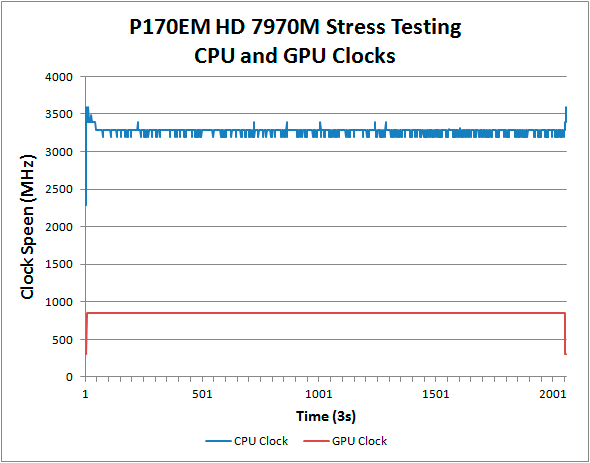
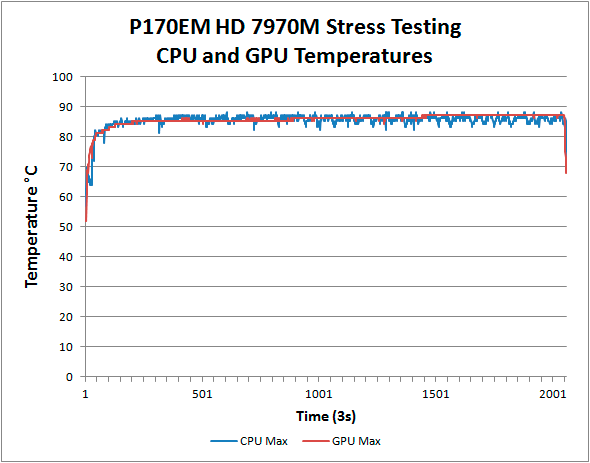
The maximum CPU temperature during our torture testing reaches 88C, which is quite good for a notebook running a high-end CPU like the i7-2720QM. Likewise, the maximum temperature on the HD 7970M is 87C. Those temperatures might not seem all that great until you consider that we’re running at 100% load for two hours with no throttling below the expected maximum turbo clocks (e.g. 3.2GHz on the CPU with all cores active). Clearly the large heatsinks, fans, and exhaust ports are doing their job, though they’re not particularly quiet.
At idle the acoustic noise measures 33.6dB from ~18 inches in front of the P170EM, under 100% CPU load the noise output reaches 38.7dB, gaming pushes the second HSF into action and we get 40.2dB, and during our full stress test we measure 42.4dB. While the idle and load noise levels are noticeable, the character of the noise isn’t all that bad, with a lower whooshing sound thanks to the size of the blower fans. Perhaps more importantly, there’s still another level of fan speed that we didn’t reach during our normal testing; when we set the laptop on our moderately shaggy carpet and covered the exhausts with our hands, after a few minutes of stress testing we were able to hit temperatures on both the CPU and GPU above 90C. The two fans operate independently, and when the CPU hit 90C the noise level jumps to 42.8dB; get the GPU to 90C as well and we get a worst-case noise result of around 46dB. Sure it’s loud at that point, but when the exhausts aren’t blocked the fans move a lot of air—it only took about five seconds after uncovering the exhausts for the temperatures to drop back down to the 85C range.










61 Comments
View All Comments
JarredWalton - Tuesday, October 2, 2012 - link
Hey, whaddayaknow! I totally missed those. I couldn't figure out why Clevo wouldn't have such keys, but for some reason the shortcuts on the 10-key area just never registered. Text updated. Thanks!junky77 - Tuesday, October 2, 2012 - link
Wouldn't it shed some light upon the issue of under utilization?junky77 - Tuesday, October 2, 2012 - link
Also, according to the notebookcheck review of the m17x-r4, the performance gets much much better without the Enduro problem, even besting the 680m in many cases. Are their results really so out of course?JarredWalton - Tuesday, October 2, 2012 - link
We have not been able to test non-Enduro 7970M yet; I'm hoping to get the M17x R4 + 7970M in some time in the near future. At that point we can get a better view of the performance with/without Enduro. (And we might have another driver updated from AMD by then as well.)ThreeDee912 - Tuesday, October 2, 2012 - link
Looks like somebody forgot to add in the battery life charts...?JarredWalton - Tuesday, October 2, 2012 - link
Fixed, thanks!halbhh2 - Tuesday, October 2, 2012 - link
It was very interesting to me to see the excellent battery life of the Samsung 7. So I know which I'd get if I suddenly needed a new laptop in that price range. Really enjoyed this article, and mostly for the detail/nuances.transphasic - Tuesday, October 2, 2012 - link
Hey Jarred. Is this a realistic solution to this Enduro nonsense?It would seem like this would be a better solution to this problem than by cobbling together a patchwork of drivers month after month for specific games in a seemingly vain and futile attempt to bypass these Mux design/Enduro problems in order to increase FPS scores.
Since AW users have a physical switch to turn it off completely, AMD should just create
a software patch to shut the stupid Enduro thing off and disabling it, and thereby solve the problem that way.
I am at a point, like a lot of 7970m owners, where I am wondering if I would be just better off spending the extra $800 for a Nvidia 680m upgrade, or just waiting for the rumored soon to be released 7990m GPU upgrade that SUPPOSEDLY has no Enduro issues. I really cannot believe that even with some supposedly better AMD drivers on the way be the end of the year that it will even come close to closing the enormous gap in gaming performance between our 7970m and the 680m.
Your thoughts?
JarredWalton - Tuesday, October 2, 2012 - link
This won't work. To turn Enduro off (like on the Alienware M17x), you need actual hardware muxes on the motherboard to route the video outputs to the iGPU or the dGPU. The P170EM (AFAIK) only has the outputs connected to the iGPU, so it will always be in Enduro or Optimus mode. Sorry!Harmattan - Tuesday, October 2, 2012 - link
I've owned both p150em and p170ems and generally agree with the assessment, albeit I felt it a bit harsh. The keyboard was not as bad as described, neither was the build quality. The p150em is, IMO, the best 15" gaming laptop available in terms of performance and size.But yes, AW has it all over Clevo on build even with a 2-year old design.
On the bright side, they did finally listen to people (after 3 years) and put back-lit keyboards on their new line.